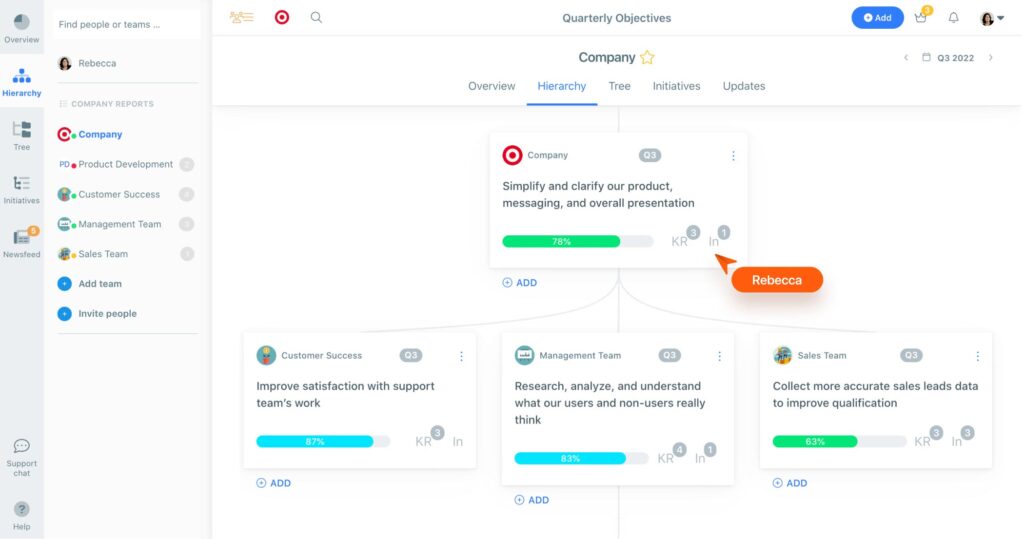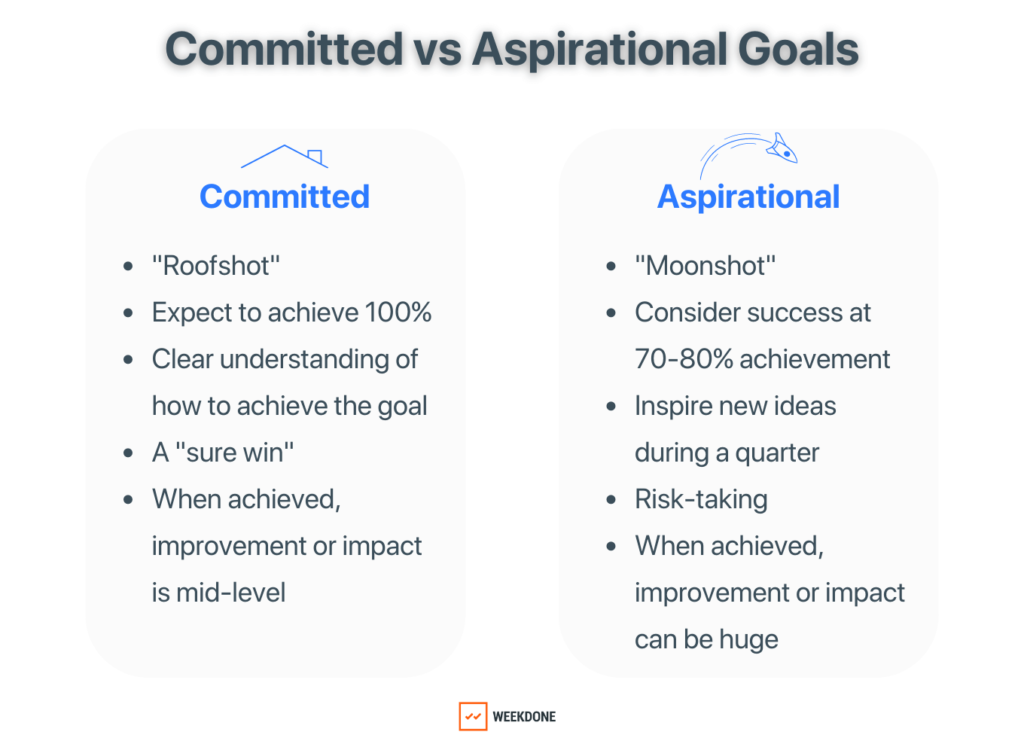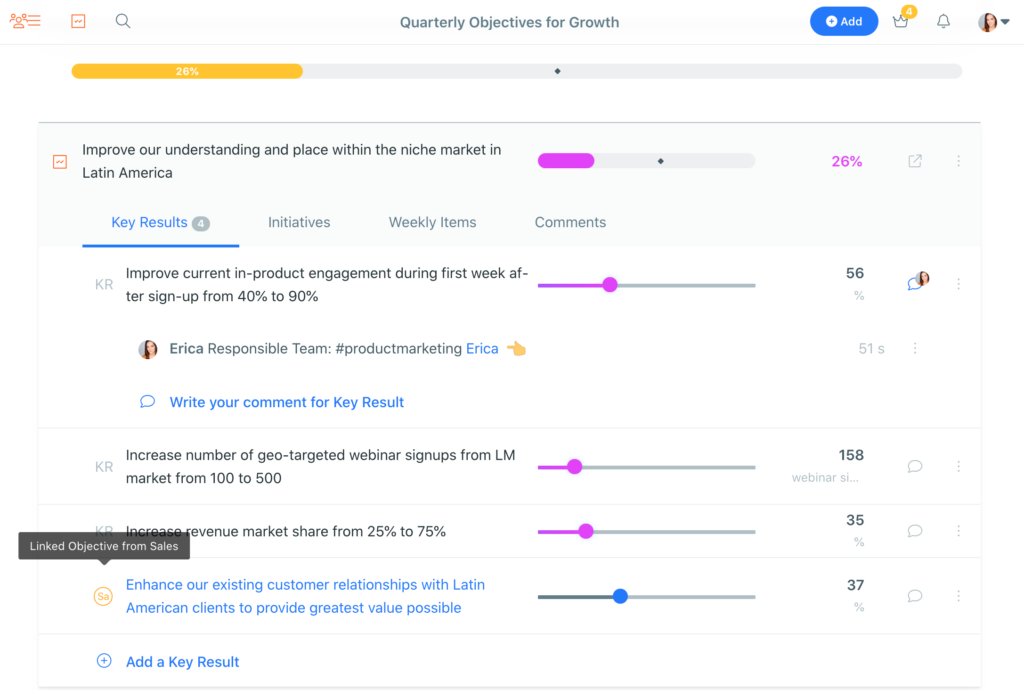In order to achieve their objectives, businesses need to set measurable goals and track their progress. This is where Objectives and Key Results (OKRs) come in. The popular methodology, plus an understanding of the company’s hierarchial stucture helps everyone stay aligned and focused from the bottom-up.
Knowing the OKR meaning for different organizational levels will help your success and adoption rate within the company. How you implement OKRs, either with software or spreadsheets depends on your company structure and needs.
This article will help you understand how to set strategic stretch goals under 5 levels:
- Company
- Cross-functional Teams
- Department
- Teams
- Personal
We call this, the OKR hierarchy. So, let’s dive in.
Try OKR Software 🎯
Set and track company-wide OKRs in OKR Software. Get started fast with built-in examples and guided OKR Wizard. Stay focused – achieve goals.
What is OKR?
The OKR framework is more than a goal-setting methodology – it is a system developed to help companies improve key business improvement areas.
The OKR methodology inspires companies to set focused, ambitious, and strategic goals while actively measuring them throughout the quarter with adjustments as necessary.
What does OKR stand for?
O = Objectives
KR = Key Results
Easy enough!
What are the components of an OKR?
The two direct components of OKR are the strategic goal (Objective) and how it’s measured (Key Results)
An Objective is a qualitative, inspiring statement that tells you what you want to achieve.
Key results are the quantitative values that you set and determine will help you measure progress towards the objective.
Note: a good rule of thumb is to set 3-5 key results per every 1 objective.
Even though an OKR can apply to several different areas of a business, they require a slightly different approach to each one.
It is crucial to know the purpose of each level in an organization and the OKR meaning for each. This will help you choose the right way to implement OKRs in your business, making it easier to achieve results.
Below are the different levels of OKRs in an organization and tips for crafting objectives and key results for each.
Try OKR Software 🎯
Set and track company-wide OKRs in OKR Software. Get started fast with built-in examples and guided OKR Wizard. Stay focused – achieve goals.
How To Set Company-Wide OKRs
In short, the OKR hierarchy is a specific view dedicated to show how all Objectives align from the Company level into teams. With this view in mind (and in sight), teams see how their work contributes to the big picture and connects with other teams as well. Company-wide alignment is the one of the greatest rewards that come from adopting OKRs.
Further, lets break down 5 common levels in a company and how Objectives and Key Results fit into each one.

1. Company Objective
The meaning of OKR for the company is to achieve proper alignment with goals across the company.
The company OKR is the tip of the umbrella. The company objective is the top-level guiding light for the entire organization.
When referring to a “company OKR” – keep in mind that only the objective is set on the company level. The key results are formed through by the objectives of those levels that fall beneath it – departments, teams, and individuals. Departments and teams should always set their own OKRs, giving them a sense of ownership and responsibility toward the business’ success.
A company objective should be broad enough to encompass the entire organization, yet specific enough to keep it agile and changing with the times. Whether your company decides to set annual or quarterly OKRs is up to you, however, we always recommend quarterly cadence as it helps facilitate discussion, innovation, and motivation among teams and individuals.
2. Cross-functional OKR
The OKR meaning for cross-functional teams is to commit and make use of individuals expertise for the benefit of a common objective.
A cross-functional team can be created when individuals from different teams pool themselves together with the purpose of working toward a common objective during the quarter.
In Weekdone, you can create a cross-functional team by simply adding the individuals to a new team and setting a Team OKR and assigning key results and Initiatives as needed. If next quarter, this team is no longer working toward a common objective, you can archive the team and still see historical data for the previous quarter.
3. Department OKR
The meaning of OKR for departments is to commit multiple teams to the outcome of one objective.
Companies may group various teams under a single department. For example: The Design, Product, and Engineering teams could be grouped together to create the Product Management Department. However, if each team has only 1-3 people, it’s still better to create a cross-functional team in your OKR software and not an overarching Department. We should always try to keep things simple, and adding an extra layer to your company structure is definitely introducing more complexity.
Creating departments is ideal for those teams who regularly work together to achieve a single Objective. Each team may be responsible for a single key result, but together they make up the progress toward the common objective.
Of course, teams within the department can set their own OKRs as well, but don’t overdo yourself – make sure the teams are capable of handling this workload. Additionally, department managers will be able to see all team updates in one progress report at the end of the week.
Take the example below from inside Weekdone product. The Growth department includes the Sales and Product Marketing teams. The Sales team has their individual OKR linked to the department level Objective, where it acts as a separate key result. Additionally, a comment is made on the KR regarding the responsible team with a mention so expectations are clear.
4. Team OKR
The meaning of OKR for teams is to keep focus, collaborate, and contribute to the most important area of need in your team.
The most commonly used OKR is set at the team level. This involves your already established teams like:
- Sales
- Marketing
- Customer Service
- Accounting
- Design
- Product
- HR
- and so on….
Team OKRs allows every individual to become involved in the process and don’t isolate any member from contributing. It still allows individuals to follow their own personal goals without restricting them in any way.
Try OKR Software 🎯
Set and track company-wide OKRs in OKR Software. Get started fast with built-in examples and guided OKR Wizard. Stay focused – achieve goals.
5. Personal OKR
The meaning of personal OKRs is to hold yourself accountable to get things done, self-evaluation.
Although personal OKRs can be set for specific use cases, they should be generally avoided. While this might seem like a good idea on the surface, it actually frustrates employees and ruins motivation to achieve goals set by the company.
Lean on team OKRs which help foster inclusion and ownership rather than singling out an employee. Personal development should always be promoted but rather through public feedback and recognition over OKRs.
What are the types of OKRs?
There are 2 types of OKRs that we talk about in Weekdone – committed and aspirational.
When used as an OKR scoring system, this predictive method describes the confidence level of how likely you are to achieve these ambitious goals by the end of the quarter.

Committed
These are your “roofshot” goals. When teams set goals with almost 100% confidence that they’ll see them through to completion.
Aspirational
These are your “moonshot” goals. These are the stretch goals embodied by the quote, “shoot for the moon because even if you miss, you’ll land amongst the stars”. These objectives are ambitious, and motivate your team to aspire for 70-80% completion – because even with that, you’d feel the challenge and know you can aim high.
Quarterly OKR Implementation Guide
Now that you understand what OKR means for different levels in the OKR hierarchy, it’s time to put that knowledge into practice. To use the framework properly, it may take some trial and error.
We recommend different implementation strategies which depend on: company structure, size, and previous OKR knowledge of your team.
Whatever you decide, it’s important to follow the process below during a 3 month (quarterly) OKR cycle.
Before the quarter:
As a new quarter approaches – around 2 weeks before – everyone should begin thinking about the next quarter. Take this time to review learnings from previous few months, brainstorm, and strategize new goals for the next quarter.
Ideate, Plan, and Write OKRs
This is your OKR planning phase. Here are two templates to help your OKR planning run smoothly and make sure you’re asking the right questions.
Use this template to put down some ideas with your team. The goal here is to generate some ideas around what could be the improvement areas of focus for your team during the next quarter. Further, you’ll rank these ideas based on their impact on revenue and how many effort hours they’ll require.
- What is the expected outcome?
- How to prioritize?
- How to execute?
Once you’ve drafted some ideas with your team, you can start writing more concrete ideas into proper OKRs for the quarter with this template.
Here is where you connect the organization in one board. You may want to set a deadline for your teams to complete this template so you can review it in the company-wide retrospective once the quarter ends.
During the quarter
So, now that everyone has defined, shared, and put their OKRs on the wall – either in a dedicated OKR software, or in an OKR tracking spreadsheet – you’re ready to start the stages of execution and regular check-ins.
Plan Initiatives
Your Initiatives are the projects that take longer than 1 or 2 weeks to complete. Typically, they are the longer term projects set by multiple team members who collaborate their efforts intended to introduce innovative ideas that impact the OKR.
Set Weekly Plans
Weekly plans are the 3-5 most important tasks you will accomplish that drive initiatives, key results, and ultimately objectives forward. For maximum efficiency, weekly plans are best set on the Friday before the following week so that everyone can jump in on Monday without wasting any time.
Have Weekly OKR Check-ins
Weekly OKR Check-Ins require everyone in each team to review their key result metrics and update the numbers in the company’s dedicated OKR tool. Keep everything up to date to ensure everyone understands the current status of OKR across the company. This also helps teams have more active and relevant discussions in their weekly team meeting.
Every other week, OKR progress meetings should happen where all teams in the company come together. These cross-functional team meetings allow each leader and responsible team members report a quick summary of their OKR progress. The time spent here is not to discuss initiatives or plans, but rather focus on problem solving and reflection – are OKRs are moving, or not? Maybe another team has insight that could help change another’s course of direction.
Have Monthly OKR reviews
Monthly OKR reviews are similar to your bi-weekly OKR progress meeting, on a wider scope. Teams should prepare individually for these. It’s time for reflection, and pushing forward in the month(s) ahead. How was team progress during the month, what did you learn and how will you change or continue along the path? It’s a chance to see the progress of the company objective as well.
End of the quarter
Quarterly review
At the end of the quarter is when you should hold the company-wide quarterly review, aka a “retrospective” meeting.
This retrospective meeting gives everyone again a chance to come together and discuss learnings, shortcomings and successes in order to optimize OKRs for the upcoming quarter.
Leaders can use the questions below as inspiration to guide your team quarterly review in preparation for the company-wide retrospective.
Use our Retrospective miro board template to be sure you cover the right points.
Then, begin the cycle all over again with OKR planning 2 weeks before the new quarter.
Try OKRs in your business
OKRs give high potential to help your business achieve company goals. By understanding how to set objectives and key results at different levels, you give yourself a tool that can be used in a multitude of ways.
Set your key objective at the company level and use that to inform OKRs for every department and team. In no time, you’ll create a cultural shift in your organization dedicated to efficiency and improvement.
